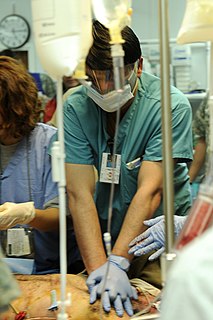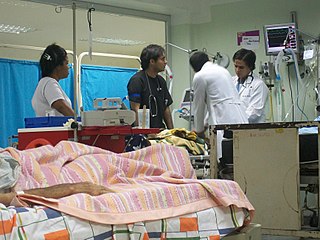Related Research Articles

First aid is the first and immediate assistance given to any person suffering from either a minor or serious illness or injury, with care provided to preserve life, prevent the condition from worsening, or to promote recovery. It includes initial intervention in a serious condition prior to professional medical help being available, such as performing cardiopulmonary resuscitation (CPR) while waiting for an ambulance, as well as the complete treatment of minor conditions, such as applying a plaster to a cut. First aid is generally performed by someone with basic medical training. Mental health first aid is an extension of the concept of first aid to cover mental health, while psychological first aid is used as early treatment of people who are at risk for developing PTSD. Conflict First Aid, focused on preservation and recovery of an individual's social or relationship well-being, is being piloted in Canada.

Cardiac arrest is a sudden loss of blood flow resulting from the failure of the heart to pump effectively. Signs include loss of consciousness and abnormal or absent breathing. Some individuals may experience chest pain, shortness of breath, or nausea immediately before entering cardiac arrest. Radiating pain to one arm is a common symptom, as is long term malaise and "general weakness of heart". If not treated within minutes, it typically leads to death.

Cardiopulmonary resuscitation (CPR) is an emergency procedure that combines chest compressions often with artificial ventilation in an effort to manually preserve intact brain function until further measures are taken to restore spontaneous blood circulation and breathing in a person who is in cardiac arrest. It is recommended in those who are unresponsive with no breathing or abnormal breathing, for example, agonal respirations.
Clinical death is the medical term for cessation of blood circulation and breathing, the two criteria necessary to sustain the lives of human beings and of many other organisms. It occurs when the heart stops beating in a regular rhythm, a condition called cardiac arrest. The term is also sometimes used in resuscitation research.
Shock is the state of insufficient blood flow to the tissues of the body as a result of problems with the circulatory system. Initial symptoms of shock may include weakness, fast heart rate, fast breathing, sweating, anxiety, and increased thirst. This may be followed by confusion, unconsciousness, or cardiac arrest, as complications worsen.

Advanced cardiac life support, or advanced cardiovascular life support, often referred to by its acronym, "ACLS", refers to a set of clinical algorithms for the urgent treatment of cardiac arrest, stroke, myocardial infarction, and other life-threatening cardiovascular emergencies. Outside North America, Advanced Life Support (ALS) is used.

Defibrillation is a treatment for life-threatening cardiac dysrhythmias, specifically ventricular fibrillation (VF) and non-perfusing ventricular tachycardia (VT). A defibrillator delivers a dose of electric current to the heart. Although not fully understood, this process depolarizes a large amount of the heart muscle, ending the dysrhythmia. Subsequently, the body's natural pacemaker in the sinoatrial node of the heart is able to re-establish normal sinus rhythm. A heart which is in asystole (flatline) cannot be restarted by a defibrillator, but would be treated by cardiopulmonary resuscitation (CPR).

Hypothermia is defined as a body core temperature below 35.0 °C (95.0 °F) in humans. Symptoms depend on the temperature. In mild hypothermia, there is shivering and mental confusion. In moderate hypothermia, shivering stops and confusion increases. In severe hypothermia, there may be paradoxical undressing, in which a person removes their clothing, as well as an increased risk of the heart stopping.

Asystole is the absence of ventricular contractions in the context of a lethal heart arrhythmia. Asystole is the most serious form of cardiac arrest and is usually irreversible. Also referred to as cardiac flatline, asystole is the state of total cessation of electrical activity from the heart, which means no tissue contraction from the heart muscle and therefore no blood flow to the rest of the body.

An automated external defibrillator (AED) is a portable electronic device that automatically diagnoses the life-threatening cardiac arrhythmias of ventricular fibrillation (VF) and pulseless ventricular tachycardia, and is able to treat them through defibrillation, the application of electricity which stops the arrhythmia, allowing the heart to re-establish an effective rhythm.

Suspended animation is the temporary slowing or stopping of biological function so that physiological capabilities are preserved. It may be either hypometabolic or ametabolic in nature. It may be induced by either endogenous, natural or artificial biological, chemical or physical means. In its natural form it may be spontaneously reversible as in the case of species demonstrating hypometabolic states of hibernation or require technologically mediated revival when applied with therapeutic intent in the medical setting as in the case of deep hypothermic circulatory arrest (DHCA).

Frostbite is a skin injury that occurs when exposed to extreme low temperatures, causing the freezing of the skin or other tissues, most commonly affecting the fingers, toes, nose, ears, cheeks and chin areas. The initial symptom is typically numbness. This may be followed by clumsiness with a white or bluish color to the skin. Swelling or blistering may occur following treatment. The hands, feet, and face are most commonly affected. Complications may include hypothermia or compartment syndrome.
Pulseless electrical activity (PEA) refers to cardiac arrest in which the electrocardiogram shows a heart rhythm that should produce a pulse, but does not. Pulseless electrical activity is found initially in about 55% of people in cardiac arrest.

A J wave — also known as Osborn wave, camel-hump sign, late delta wave, hathook junction, hypothermic wave, K wave, H wave or current of injury — is an abnormal electrocardiogram finding.

Vesicular monoamine transporter 1 (VMAT1) also known as chromaffin granule amine transporter (CGAT) or solute carrier family 18 member 1 (SLC18A1) is a protein that in humans is encoded by the SLC18A1 gene. VMAT1 is an integral membrane protein, which is embedded in synaptic vesicles and serves to transfer monoamines, such as norepinephrine, epinephrine, dopamine, and serotonin, between the cytosol and synaptic vesicles. SLC18A1 is an isoform of the vesicular monoamine transporter.
Deep hypothermic circulatory arrest (DHCA) is a surgical technique that induces deep medical hypothermia. It involves cooling the body to temperatures between 20 °C (68 °F) to 25 °C (77 °F), and stopping blood circulation and brain function for up to one hour. It is used when blood circulation to the brain must be stopped because of delicate surgery within the brain, or because of surgery on large blood vessels that lead to or from the brain. DHCA is used to provide a better visual field during surgery due to the cessation of blood flow. DHCA is a form of carefully managed clinical death in which heartbeat and all brain activity cease.
Targeted temperature management (TTM) previously known as therapeutic hypothermia or protective hypothermia is an active treatment that tries to achieve and maintain a specific body temperature in a person for a specific duration of time in an effort to improve health outcomes during recovery after a period of stopped blood flow to the brain. This is done in an attempt to reduce the risk of tissue injury following lack of blood flow. Periods of poor blood flow may be due to cardiac arrest or the blockage of an artery by a clot as in the case of a stroke.
The Arctic Sun Temperature Management System is a non-invasive targeted temperature management system, a medical device used to modulate patient temperature with precision by circulating chilled water in pads directly adhered to the patient's skin. Using varying water temperatures and a sophisticated computer algorithm, a patient's body temperature can be controlled to the nearest 0.2 °C. It is produced by Medivance, Inc. of Louisville, Colorado.
Afterdrop is a continued cooling of a patient's core temperature during the initial stages of rewarming from hypothermia.

Alan M. Steinman is an American physician, retired U.S. Public Health Service Commissioned Corps rear admiral, who served with the U.S. Coast Guard for the majority of his commissioned corps career. His final assignment was serving as the Coast Guard's chief medical officer. Steinman is expert in sea survival, hypothermia and drowning, and an advocate for the open service of LGBT people in the U.S. military.
References
- 1 2 Tveita, T. (2000-10-01). "Rewarming from hypothermia. Newer aspects on the pathophysiology of rewarming shock". International Journal of Circumpolar Health. 59 (3–4): 260–266. ISSN 1239-9736. PMID 11209678.
- 1 2 3 Brown, DJ; Brugger, H; Boyd, J; Paal, P (Nov 15, 2012). "Accidental hypothermia". The New England Journal of Medicine. 367 (20): 1930–8. doi:10.1056/NEJMra1114208. PMID 23150960.
- ↑ ECC Committee, Subcommittees and Task Forces of the American Heart Association (December 2005). "2005 American Heart Association Guidelines for Cardiopulmonary Resuscitation and Emergency Cardiovascular Care". Circulation. 112 (24 Suppl): IV–136. doi: 10.1161/CIRCULATIONAHA.105.166550 . PMID 16314375.